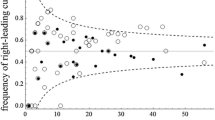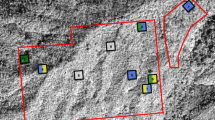Abstract
I compare forager size and foraging ecology of the leaf-cutting ant Acromyrmex coronatus (Fabricius) with published data on three other leaf-cutter species in Costa Rica, Atta cephalotes (L.), Acromyrmex octospinosus (Reich), and Acromyrmex volcanus Wheeler. Intra-and interspecific differences in forager size in these leaf-cutting ants appear to reflect the economics of harvesting different preferred resources. Ac. coronatus colonies have relatively small foragers (mean mass=3.4±1.4 mg) that cut almost exclusively the thin, soft leaves and other parts of small herbaceous plants. Similarly, small A. cephalotes colonies have small foragers (3.3±1.0 mg) that attack the leaves of small herbaceous plants. In contrast, mature A. cephalotes colonies have a wider sizerange of foragers (7.3±4.1 mg) that primarily attack the leaves of trees, with larger foragers cutting thicker, tougher leaves. In A. cephalotes, the match of forager size to leaf type (both ontogenetically and behaviorally) increases foraging efficiency. Extreme forager polymorphism in mature A. cephalotes colonies appears to broaden the diversity of tree species that they can exploit efficiently. Ac. octospinosus and Ac. volcanus both have large, relatively monomorphic foragers (13.3±4.2 mg and 30.6±4.3 mg, respectively) that typically scavenge for pieces of fallen vegetation, such as dead leaves, fruit, and flowers, in addition to cutting herbs. The large foragers of Ac. octospinosus and Ac. volcanus appear to be well suited as generalist foragers, able to cut or collect any desirable vegetation encountered. Ac. coronatus is similar to A. cephalotes in other ways. Both Ac. coronatus and A. cephalotes establish and maintain cleared trunk trails for foraging, and both have minima workers that “hitchhike” on the loads carried by foragers, apparently serving to protect the larger foragers from attack by phorid flies. Trunk trails and hitchhikers are not known for Ac. octospinosus and Ac. volcanus. That A. coronatus and A. cephalotes show little overlap in geographic distribution within Costa Rica may relate both to differences in habitat requirements and to interspecific competition.
Similar content being viewed by others
References
Benavides AG, Cancino JM, Ojeda EP (1994) Ontogenetic changes in gut dimensions and macroalgal digestibility in the marine herbivorous fish, Aplodactylus punctatus. Funct Ecol 8:46–51
Calder WA III (1984) Size, function, and life history. Harvard University Press, Cambridge, Mass
Coelho JR, Hoagland J (1995) Load-lifting capacities of three species of yellowjackets (Vespula) foraging on honey-bee corpses. Funct Ecol 9:171–174
Davidson D (1977) Species diversity and community organization in desert seed-eating ants. Ecology 58:711–724
Elton CS (1927) Animal ecology. Sidgwick and Jackson, London
Feener DH Jr, Moss KAG (1990) Defense against parasites by hitchhikers in leaf-cutting ants: a quantitative assessment. Behav Ecol Sociobiol 26:17–29
Forsman A, Lindell LE (1993) The advantage of a big head: swallowing performance in adders, Vipera berus. Funct Ecol 7: 183–189
Fowler HG (1978) Foraging trails of leaf-cutting ants. NY Entomol Soc 86:132–136
Fowler HG (1979) Las hormigas cortadoras del Paraguay de los generos Atta Fabricius y Acromyrmex Mayr: bionomico, distribucion y sistematica. Inf Cient Paraguay 2:30–70
Fowler HG (1983) Distribution patterns of Paraguayan leaf-cutting ants (Atta and Acromyrmex) (Formicidae: Attini). Stud Neotrop Fauna Environ 18:121–138
Fowler HG (1985) Leaf-cutting ants of the genera Atta and Acromyrmex of Paraguay (Hymenoptera Formicidae). Dtsch Entomol Z 32:19–34
Fowler HG (1992) Patterns of colonization and incipient nest survival in Acromyrmex niger and Acromyrmex balzani (Hymenoptera: Formicidae) Insectes Soc 39:347–350
Fowler HG, Robinson SW (1979) Foraging by Atta sexdens (Formicidae: Attini): seasonal patterns, caste and efficiency. Ecol Entomol 4:239–247
Fowler HG, Forti LC, Pereira-da-Silva V, Saes NB (1986) Economics of grass-cutting ants. In: Lofgren CS, Vander Meer RK (eds) Fire ants and leaf-cutting ants. Westview, Boulder, pp 18–35
Fowler HG, Bernardi JVE, Delabie JC, Forti LC, Pereira-da-Silva V (1989) Major ant problems of South America. In: Vander Meer RK, Jaffe K, Cedeno A (eds) Applied myrmecology, a world perspective. Westview, Boulder, pp 3–14
Gonçalves CR (1967) As formigas cortadeiras da Amazônia, dos gêneros “Atta” Fabr. e' Acromyrmex” Mayr (Hym., Formicidae). Ata Simpósio Biota Amazôn 5:181–202
Gordon IJ, Illius AW (1994) The functional significance of the browser-grazer dichotomy in African ruminants. Oecologia 98:167–175
Hölldobler B, Wilson EO (1990) The ants. Harvard University, Press, Cambridge, Mass
Hubbell SP, Johnson LK, Stanislav E, Wilson B (1980) Foraging by bucket-brigade in leaf-cutter ants. Biotropica 12:210–213
Hutchinson GE (1959) Homage to Santa Rosalia, or Why are there so many kinds of animals? Am Nat 93:145–159
Lindström J, Kaila L, Niemelä P (1994) Polyphagy and adult body size in geometrid meths. Oecologia 98:130–132
Mintzer A (1979) Foraging activity of the Mexican leaf-cutting and Atta mexicana (F. Smith), in a Sonoran Desert habitat (Hymenoptera, Formicidae). Insectes Soc 26:364–372
Nichols-Orians CM, Schultz JC (1989) Leaf toughness affects leaf harvesting by the leaf-cutter ant, Atta cephalotes (L.) (Hymenoptera: Formicidae). Biotropica 21:80–83
Orr MR (1993) Parasitic flies (Diptera: Phoridae) influence foraging rhythms and caste division of labor in the leaf-cutter ant, Atta cephalotes (Hymenoptera: Formicidae). Behav Ecol Sociobiol 30:395–402
Oster GF, Wilson EO (1978) Caste and ecology in the social insects. Princeton University Press, Princeton
Pereira-da-Silva V, Forti LC, Cardoso LG (1981) Dinãmica populacional e caracterização dos ninhos de Acromyrmex coronatus (Fabricius, 1804) (Hymenoptera, Formicidae). Rev Brasil Entomol 25:87–93
Peters RH (1983) The ecological implications of body size. Cambridge University Press, Cambridge, UK
Reiss MJ (1989) The allometry of growth and reproduction. Cambridge University Press, Cambridge, UK
Rockwood LL (1976) Plant selection and foraging patterns in two species of leaf-cutting ants (Atta). Ecology 57:48–61
Schmidt-Nielsen K (1984) Scaling. Why is animal size so important. Cambridge University Press, Cambridge, UK
Shindler DE, Johnson BM, MacKay NA, Bouwes N, Kitchell JF (1994) Crab: snail size-structured interactions and salt marsh predation gradients. Oecologia 97:49–61
Simberloff D, Boecklen W (1981) Santa Rosalia reconsidered: size ratios and competition. Evolution 35:1206–1228
Vasconcelos HL (1990) Foraging activity of two species of leaf-cutting ants (Atta) in a primary forest of the central Amazon. Insectes Soc 37:131–145
Weber NA (1946) The biology of the fungus-growing ants. Part IX. The British Guiana species. Rev Entomol 17:114–172
Weber NA (1972) Gardening ants: the attines. American Philosophical Society, Philadelphia
Werner EE (1994) Ontogenetic scaling of competitive relations: size-dependent effects and responses in two anuran larvae. Ecology 75:197–213
Werner EE, Gilliam J (1984) The ontogenetic niche and species interactions in size-structured populations. Annu Rev Ecol Syst 15:393–425
Wetterer JK (1990a) Diel changes in forager size, activity, and load selectivity in a tropical leaf-cutting ant, Atta cephalotes. Ecol Entomol 15:97–104
Wetterer JK (1990b) Load-size determination in leaf-cutting ants. Behav Ecol 1:95–101
Wetterer JK (1991a) Allometry and the geometry of leaf-cutting in Atta cephalotes. Behav Ecol Sociobiol 29:347–351
Wetterer JK (1991b) Foraging ecology of the leaf-cutting ant, Acromyrmex octospinosus, in a Costa Rican rain forest. Psyche 98:361–371
Wetterer JK (1993) Foraging and nesting ecology of a Costa Rican leaf-cutting ant, Acromyrmex volcanus. Psyche 100:65–76
Wetterer JK (1994a) Nourishment and evolution in fungus-growing ants and their fungi. In: Hunt JH, Nalepa CA (eds) Nourishment and evolution in insect societies. Westview, Boulder, pp 309–328
Wetterer JK (1994b) Forager polymorphism, size-matching, and load delivery in the leaf-cutting ant, Atta cephalotes. Ecol Entomol 19:57–64
Wetterer JK (1994c) Ontogenetic changes in forager polymorphism and foraging ecology in the leaf-cutting ant, Atta cephalotes. Oecologia 98:235–238
Wilson EO (1980a) Caste and division of labor in leaf-cutter ants. I. The overall pattern in A. sexdens. Behav Ecol Sociobiol 7: 143–156
Wilson EO (1980b) Caste and division of labor in leaf-cutter ants. II. The ergonomic organization of leaf cutting. Behav Ecol Sociobiol 7:157–165
Wilson EO (1983a) Caste and division of labor in leaf-cutter ants. III. Ergonomic resiliency in foraging by A. cephalotes. Behav Ecol Sociobiol 14:47–54
Wilson EO (1983b) Caste and division of labor in leaf-cutter ants. IV. Colony ontogeny of A. cephalotes. Behav Ecol Sociobiol 14:55–60
Author information
Authors and Affiliations
Rights and permissions
About this article
Cite this article
Wetterer, J.K. Forager size and ecology of Acromyrmex coronatus and other leaf-cutting ants in Costa Rica. Oecologia 104, 409–415 (1995). https://doi.org/10.1007/BF00341337
Received:
Accepted:
Issue Date:
DOI: https://doi.org/10.1007/BF00341337




